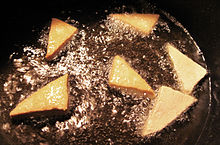| This article needs additional citations for verification. Please help improve this article by adding citations to reliable sources. Unsourced material may be challenged and removed. Find sources: "Shallow frying" – news · newspapers · books · scholar · JSTOR (June 2014) (Learn how and when to remove this message) |

Shallow frying is a hot oil-based cooking technique. It is typically used to prepare portion-sized cuts of meat, fish, potatoes and patties such as fritters. Shallow frying can also be used to cook vegetables.
Technique
It is a medium-high to high heat cooking process. Temperatures between 160–190 °C (320–374 °F) are typical, but shallow frying may be performed at temperatures as low as 150 °C (302 °F) for a longer period of time. The high heat promotes protein denaturation-browning and, in some cases, a Maillard reaction. Deep-frying usually takes place at temperatures between 177–205 °C (351–401 °F) so shallow-frying can oftentimes be considered a less intense cooking technique. Foods to be shallow fried are commonly pre-portioned into single servings before being placed in oil. Since the food is only partly submerged, it must be turned over partway through the cooking process. Some cooks recommend cooking the "presentation" side of the food first.
Dishes
Both deep-fried and shallow-fried foods are often battered, breaded or floured (usually with wheat flour or corn starch) prior to being cooked; this step is sometimes referred to as breading, crumbing, velveting or dredging depending on the ingredients being used. The structure of these starchy coatings become rigid and porous when heated in oil; this is due to their high amylose content. Rigid coatings increase the palatability of fried food by inhibiting moisture loss and creating the desirable ‘crispiness’ trait.
Health
Further information: Frying § Health Further information: Deep frying § HealthThe healthfulness of shallow frying has been scrutinized in literature. The results of a study on fish fry found that shallow frying fish provoked higher thermo-oxidation than cooking in a microwave. Studies have shown that margarine, virgin olive oil and similar cooking oils oxidize and destabilize substantially when they are shallow-fried, especially when compared to oils used during baking. In turn, a large amount of heat-sensitive nutrients may degrade, and antioxidant properties are lost. In this regard, shallow frying food may be a healthier alternative to long-term deep-frying processes. The fat-soluble vitamins and fatty acids in cooking oils show comparatively reasonable stability when they are used for shallow frying rather than deep frying.
Despite being a less intense frying method, the adverse effects of shallow frying are analogous to the ones associated with deep frying in some regards. The oil absorption rates of shallow-fried foods are similar to that of foods that have been deep-fried at proper temperatures; consequently, shallow-frying is not a better alternative for calorie control or weight management. Some research shows shallow frying and deep frying highly increased the acrylamide content in foods like potatoes and grains to a similar degree. Roasting the same potatoes kept acrylamide production comparatively low in spite of being cooked at a higher temperature setting. It is controversial whether dietary acrylamide poses a substantial danger, but since the Joint Food and Agriculture Organization/World Health Organization Expert Committee on Food Additives concluded that acrylamide is a human health concern there have been efforts to discover methods of decreasing its formation. It has been observed that blanching, pre-soaking food in either distilled water or acidulated water and lowering frying temperature can all partially attenuate acrylamide formation.
See also
References
- Pedreschi, Franco; Kaack, Karl; Granby, Kit (1 September 2004). "Reduction of acrylamide formation in potato slices during frying". LWT - Food Science and Technology. 37 (6): 679–685. doi:10.1016/j.lwt.2004.03.001. ISSN 0023-6438.
- "Why Starch Gets Crispy When Fried | Cook's Illustrated". www.cooksillustrated.com. Retrieved 16 October 2020.
- Nieva-Echevarría, Barbara; Manzanos, María; Guillén, María; Goicoechea, Encarnación (June 2016). Written at Vitoria, Spain. "The influence of frying technique, cooking oil and fish species on the changes occurring in fish lipids and oil during shallow-frying, studied by 1H NMR". Food Technology, Faculty of Pharmacy. Food Research International. 84. Lascaray Research Center, University of the Basque Country (published 31 March 2016): 150–159. doi:10.1016/j.foodres.2016.03.033 – via Science Direct.
- Kalogeropoulos, Nick; Mylona, Anastasia; Chiou, Antonia; Ioannou, Maria S.; Andrikopoulos, Nikolaos K. (1 August 2007). "Retention and distribution of natural antioxidants (α-tocopherol, polyphenols and terpenic acids) after shallow frying of vegetables in virgin olive oil". LWT - Food Science and Technology. 40 (6): 1008–1017. doi:10.1016/j.lwt.2006.07.003. ISSN 0023-6438.
- Hrncirik, Karel (2010). "Stability of fat-soluble vitamins and PUFA in simulated shallow-frying". Lipid Technology. 22 (5): 107–109. doi:10.1002/lite.201000018. ISSN 1863-5377.
- Sweetser, W. (2004). The Ultimate Fryer Cookbook. Quintet Book. Running Press. p. 6. ISBN 978-0-7624-1963-0. Retrieved 18 May 2015.
- Nutrition, Center for Food Safety and Applied (3 February 2020). "Acrylamide and Diet, Food Storage, and Food Preparation". FDA. Retrieved 23 February 2021.
- Murniece, Irisa; Karklina, Daina; Galoburda, Ruta (24 March 2013). "The Content of Acrylamide in Deep-fat Fried, Shallow Fried and Roasted Potatoes". doi:10.5281/zenodo.1071376. Retrieved 23 February 2021.
{{cite journal}}: Cite journal requires|journal=(help) - Nutrition, Center for Food Safety and Applied (30 March 2020). "Acrylamide Questions and Answers". FDA. Retrieved 23 February 2021.
- Pedreschi, Franco; Kaack, Karl; Granby, Kit (1 September 2004). "Reduction of acrylamide formation in potato slices during frying". LWT - Food Science and Technology. 37 (6): 679–685. doi:10.1016/j.lwt.2004.03.001. ISSN 0023-6438. Retrieved 23 February 2021.
| Cooking techniques | |||||||
|---|---|---|---|---|---|---|---|
| List of cooking techniques | |||||||
| Dry |
| ||||||
| Wet |
| ||||||
| Fat-based |
| ||||||
| Mixed medium | |||||||
| Device-based | |||||||
| Non-heat | |||||||
| See also | |||||||